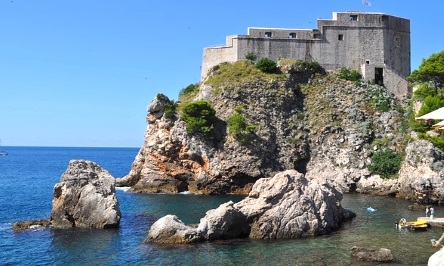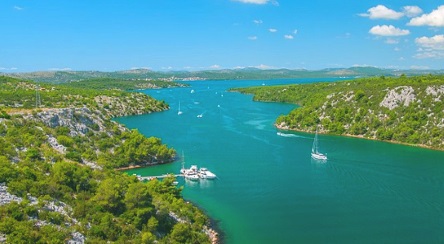Croatia is a country between Central Europe, Eastern Europe and the Balkans. While the northern neighbour Slovenia is generally counted as part of Central Europe, the classification of Croatia is disputed.
Croatia has about 4.2 million inhabitants, which is less than the average German state. Germany has about 19 times more inhabitants, Austria slightly more than twice as many. Croatia has an area of around 56,000 square kilometres. This makes Croatia larger than Switzerland, but smaller than Austria. Because the national territory has a rather elongated shape, the distances within Croatia can nevertheless be quite large. From Osijek in the northeast to Dubrovnik in the southwest, it is over 500 kilometres by road.

The coastline of Croatia is over 6,000 kilometres long. Of this, however, more than 4,000 kilometres are on the many islands, while the coastline of the mainland is approximately 1,750 kilometres long. 46 of the Croatian islands in the Mediterranean are inhabited. The largest island is Krk in the north of the country with about 400 km² and 18,000 inhabitants.
The largest cities in Croatia are the capital Zagreb as well as Osijek, Split and Rijeka. All other cities have less than 100,000 inhabitants. Some cities on the Mediterranean with ancient sights, such as Dubrovnik and Pula, are focal points of tourism. The Croatian national parks, above all the Plitvice Lakes National Park, are also popular with holidaymakers. Croatia is not only a bathing destination, but also a hiking country.

Croatia has been a member of the European Union since 1 July 2013. It is currently the youngest of the 28 EU states. Croatia still has its own currency. However, the kuna could be replaced by the euro in a few years. Unfortunately, the economic upswing hoped for after Croatia’s entry into the EU has failed to materialise. Foreign investment in particular did not develop as hoped. Unemployment and national debt are high, and incomes are low by European standards. Only Bulgaria and Romania are considered poorer than Croatia in the European Union. Per capita income in Poland and Hungary is similar.
The languages Croatian and Serbian are very similar, there is even the term “Serbo-Croatian language”. However, the writing is different. The Croatian language uses Latin letters, the Serbian language the Cyrillic alphabet. The two states also differ in religion. The people in Croatia are mostly Catholic, but in Serbia they are Orthodox.
An important branch of the economy is tourism. Most tourists travel to the coast and the islands. Hikers can be found in the national parks, city tourists more and more in the interesting capital Zagreb. Many tourists from Germany and Austria come to Croatia by car. Especially the northern sections of the Mediterranean coast can be reached quickly by car from Central Europe. These include Istria, the Kvarner Bay and some islands such as Krk or Cres. Most tourists come to the southern parts of the Croatian coast (Dalmatia with Split and Dubrovnik) by plane.
You can also travel to Croatia by ferry, especially from Italy. There are regular ferry connections across the Adriatic (Mediterranean) from Venice, Ancona and Bari, among others. However, there are many more ferries between the Croatian mainland and the offshore islands. Smaller islands often have no airport and can only be reached by ferry.

All about Venice Airport water taxis: prices, booking, etc,
